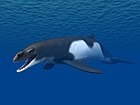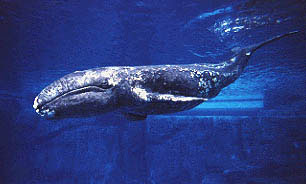
Eschrichtiidae or the gray whales is a family of baleen whale with a single extant species, the gray whale, as well as three described fossil genera: Archaeschrichtius and Eschrichtioides from the Miocene and Pliocene of Italy respectively, and Gricetoides from the Pliocene of North Carolina. More recent phylogenetic studies have found this family to be invalid, with its members nesting inside the Balaenopteridae. The names of the extant genus and the family honours Danish zoologist Daniel Eschricht.

Édouard Joseph Louis Marie Van Beneden was a Belgian embryologist, cytologist and marine biologist. He was professor of zoology at the University of Liège. He contributed to cytogenetics by his works on the roundworm Ascaris. In this work he discovered how chromosomes organized meiosis.

Cetotheriidae is a family of baleen whales. The family is known to have existed from the Late Oligocene to the Early Pleistocene before going extinct. Although some phylogenetic studies conducted by Fordyce & Marx 2013 recovered the living pygmy right whale as a member of Cetotheriidae, making the pygmy right whale the only living cetotheriid, other authors either dispute this placement or recover Neobalaenidae as a sister group to Cetotheriidae.

Parietobalaena is an extinct genus of baleen whale, belonging to the family Pelocetidae. Fossils are found in Miocene-aged marine strata in North America, Europe, Australia and Japan.

Balaenula is an extinct genus of cetacean.

Scaldicetus is an extinct genus of highly predatory macroraptorial sperm whale. Although widely used for a number of extinct physeterids with primitive dental morphology consisting of enameled teeth, Scaldicetus as generally recognized appears to be a wastebasket taxon filled with more-or-less unrelated primitive sperm whales.
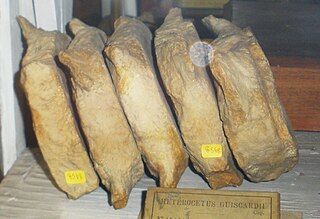
Heterocetus is a dubious genus of extinct cetacean.
Eocetus is an extinct protocetid early whale known from the early late Eocene Giushi Formation in Gebel Mokattam, outside Cairo, Egypt. The specimen was first named by Fraas as Mesocetus schweinfurthi. However, the name Mesocetus was previously used causing a change to the species name to Eocetus schweinfurthi. Since the genus was first described in the early 20th century, several other specimens, mostly isolated vertebrae, have been attributed to Eocetus, but the taxonomic status of these widely distributed specimens remain disputed.
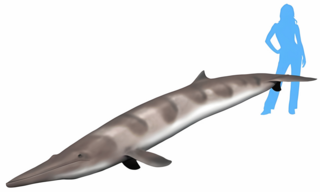
Herpetocetus is a genus of cetotheriid mysticete in the subfamily Herpetocetinae.
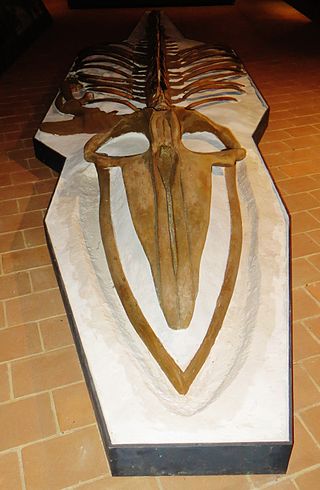
Protororqualus is a genus of extinct rorqual from the late Pliocene of Mount Pulgnasco, Italy.
Plesiocetus is a genus of extinct balaenopterids found worldwide. It has had a chequered taxonomic history, having served as a wastebasket genus for a handful of mysticete species.

Cetotheriopsis is a genus of extinct cetaceans of the family Cetotheriopsidae.
Monotherium is an extinct genus of phocid belonging to the subfamily Monachinae. It is known from fossils found in the middle to late Miocene of Belgium.
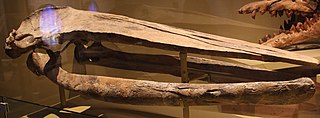
Aglaocetus is a genus of extinct baleen whales known from the Miocene of Patagonia, the US Eastern Seaboard, Japan and the Low Countries. It was once considered a member of Cetotheriidae along with many other putative cetotheres, but was recently recognized as representing a distinct family from true Cetotheriidae.
Eomysticetidae is a family of extinct mysticetes belonging to Chaeomysticeti. It is one of two families in the basal chaeomysticete clade Eomysticetoidea.

Tranatocetus is an extinct genus of mysticete from the late Miocene (Tortonian) of Jutland, Denmark. The type and only species is Tranatocetus argillarius.
Isocetus is an extinct genus of baleen whale belonging to the clade Thalassotherii. Remains have been found in middle Miocene marine deposits in Belgium.
Eudelphis is an extinct genus of sperm whale belonging to Physeteroidea that lived in the ancient North Sea basin about 16-11 million years ago, during the middle Miocene (Langhian).

Microcotyle donavini is a species of monogenean, parasitic on the gills of a marine fish. It belongs to the family Microcotylidae.
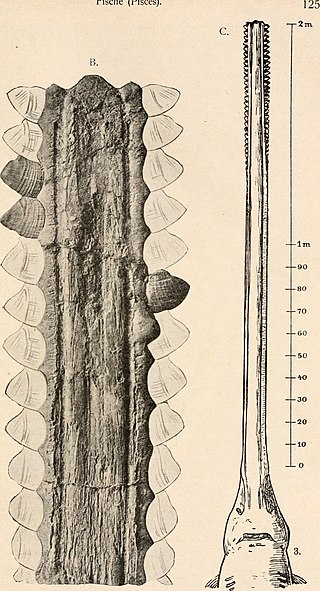
Propristis is an extinct genus of sawfish that lived from the Eocene to the Miocene. It contains two valid species, P. schweinfurthi and P. mayumbensis. It has been found in Egypt, Cabinda, Morocco, Qatar, Spain, the United Kingdom, and the United States. Isolated rostral denticles are the most common remains, but rostra have also been found.















